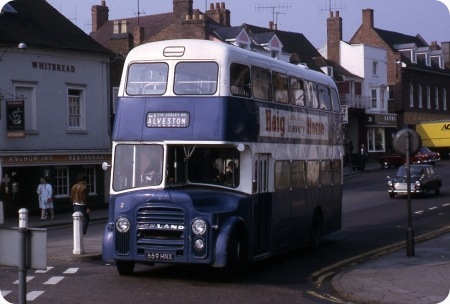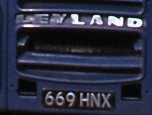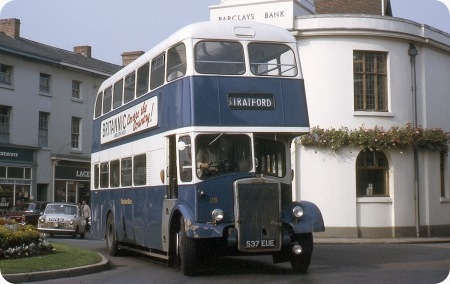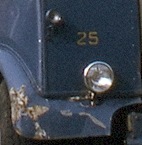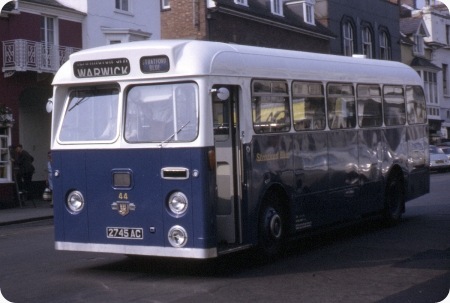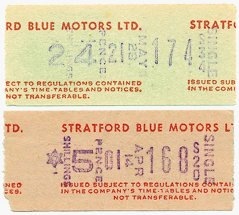Stratford Blue – Leyland Titan – 669 HNX – 2
Stratford-upon-Avon Blue Motors Ltd
1963
Leyland Titan PD3A/1
Willowbrook H41/32F
This the third and last shot in my series of Stratford Blue vehicles it is fleet number 2 registration 669 HNX. A Leyland Titan PD3A/1 with a Willowbrook highbridge body dating from 1963. Interestingly as my second posting of the exposed radiator Stratford Blue Titan No.25 which had frontal damage this vehicle also has frontal damage a large chunk of its glass fibre front radiator grill is missing.
Photograph and Copy contributed by Roger Cox
———
24/07/12 – 18:23
Is it accident damage or a modification as I looks rather neatly cut?
It was quite common at Yorkshire Traction for all three lower bars to be removed and replaced by wire mesh, as an aid to cooling, perhaps?
Eric Bawden
———
25/07/12 – 07:14
The reason for the mod at Tracky was for a reason a little less technical!, the slats kept getting broken by ham fisted (footed?)conductors standing on them whilst trying to reach up and change the destination blind.
Andrew Charles
———
25/07/12 – 07:15
More likely that it was stood on and broken when someone was changing the destination blind.
Ronnie Hoye
———
25/07/12 – 07:15
This type of damage was often caused by the feet of crews as they changed the destination indicator. Salford a fleet with very high standards used extra long destination gear to prevent this type of damage.
Chris Hough
———
25/07/12 – 11:21
Yes Andrew, that less technical reason dawned on me just after I sent my original message!
Eric Bawden
———
25/07/12 – 16:53
From about 1955 onwards, on all Tynemouth’s vehicles ‘Northern General Group’ the destination blinds were changed to the inside upstairs, access was gained by lowering a flap to get at the handles However, the flaps weren’t lockable, and especially on school runs you would usually complete the run displaying some very strange destinations. WORKMAN BAD or PRIVATE SEX were quite common along with SCHOOLARS ABC
Ronnie Hoye
———
26/07/12 – 07:45
I can’t decide whether the "St Helens" glass-fibre front is a masterpiece of raw industrial design or just plain ugly. Similarly the LAD goods vehicle cab front, with which it – perhaps understandably – bears some affinity. Ah! but the livery: I’d allow anything in that – way better than the striped lilac shockers that now run my way.
To pick up on Chris’s post of the 25th: it does look as though Stratford Blue had extended the destination gear . . . although not to the extent that Salford did, and with the consequences evident in the photograph.
Philip Rushworth
———
26/07/12 – 14:00
Ronnie’s comment reminds me that Trent also had interior access to the destination blind. I seem to remember the whole assembly was mounted on a panel that was hinged at the bottom edge and secured by a couple of budget locks. About age 8 I guess, I was with my parents heading into Nottingham one Saturday evening on a 61, front seat upstairs. The conductor came up after Bulwell to change the blind (not misleading as no one else could be picked up inside NCT territory). After unlocking the panel he saw me watching with interest and said, "’Ere – you can do this for me – wind it on ter Mansfield!" It made my day (I know, I know – little things please little minds!)
Stephen Ford
———
27/07/12 – 08:27
What was it about destination blinds that fascinated little boys? I remember being taken to an exhibition in 1956 to mark the centenary of my home town Rochdale becoming a County Borough. There was a mock-up of Rochdale Corporation’s bus destination gear in a big box on a stand and anyone was invited to play with the handles and set the blinds. Oh what bliss! I don’t remember anything else about the exhibition. I spent all day setting up the proper displays with number, destination and via details only for other kids to keep interfering and just winding for fun. Philistines!
Philip Halstead
———
27/07/12 – 08:35
The diversion into the merits or otherwise of having blinds changed on the upper deck reminds me of the days when Southampton had a balloon festival, served by a special bus service, and I was usually the conductor on a Regent V – it meant a welcome change from driving my desk! At each end of the route, the blind had to be changed and, though it was a free service, tickets were issued, so there was plenty of running up and down the stairs. It’s an incredibly pleasant way of burning off the excess blubber!
Pete Davies
———
27/07/12 – 15:30
Some front destination blinds were changed by the driver inside the cab. It must have been in either Leyland or Weymann bodies, but I can’t remember which, (information, anybody?). A Maidstone & District PD2 was involved in what was then the worst ever accident involving a PSV, (it may still be), when it was driven into a column of naval cadets in Chatham. The driver claimed to have blacked out; M&D staff – I was told the story by a Gillingham dispatcher – suspected that the driver was distracted changing the screen as he approached the terminus.
Roy Burke
———
27/07/12 – 15:31
Philip, it’s a relief to know I’m not the only sad person on here! One reason for the fascination – and why I, for one, would always stop and watch mesmerised when a blind was being changed, was to catch a fleeting glimpse of rarely used destinations – including some that had fallen out of use because of route changes. But I think the other thing was the ability to fiddle around with a mechanical contrivance that worked better than anything you could build in Meccano. For the same reason, bells of all shapes and descriptions also fascinated me – and ticket machines.
Stephen Ford
———
28/07/12 – 08:31
I remember that one, Roy, at the time. I seem to recall that he drove into the bus queue waiting at the stop.
And there are no sad folk on this website, Stephen, only happy but eccentric ones!
Chris Hebbron
———
28/07/12 – 11:03
The story as I heard it, Chris, was that the cadets were marching in formation to Chatham Dockyard in the same direction as the bus, so weren’t looking out for it, and the combination of the badly lit road and their dark uniforms, (and, allegedly, changing the blind as he was driving), led to the driver not seeing them.
BTW, while writing, thanks for your information about AFR Carling, (the recent WY posting). I met him once or twice – not always in the happiest of circumstances – and he had a lovely house right in the middle of my patch when I worked for Southdown.
Roy Burke
———
28/07/12 – 16:00
Okay, Roy you’re right – I’ve just looked it up, 1951 and 24 youngsters died. Sad business, doubly so if the driver did take his eye off the road.
Glad you found my Southdown comments useful, he certainly had a memorable war, along with many others!
Chris Hebbron
———
29/07/12 – 08:55
Sorry to go off on another old-bus-photos tangent, but your remarks about AFR Carling, Chris, revived many long dormant memories. You’ve said he was Area Manager, Portsmouth, during WWII, and became General Manager in 1947. What about the intermediate post of Traffic Manager? How long was Mr Carling GM of Southdown before going to Stratton House, and who followed him? George Duckworth was GM in my time.
Roy Burke
———
02/01/13 – 07:34
Just a slight correction, Roy, the bus involved in the Chatham disaster was apparently Chatham & District 875 (GKE 69), a 1939 Weymann-bodied Bristol K5G. Chatham & District were absorbed into Maidstone & District c1955 and of the batch of 37 (870-906) the 25 surviving at the time became M & D DH293-317. One of the batch, C & D 874, has been owned by the Friends of Chatham Traction for many years – I believe it is currently undergoing extensive restoration.
David Call
Quick links to the - Comments Page - Contact Page - Home Page
